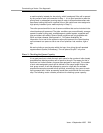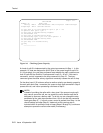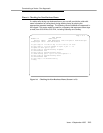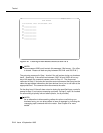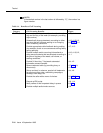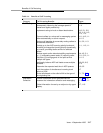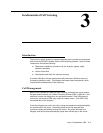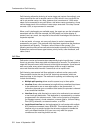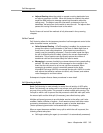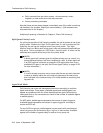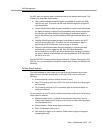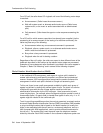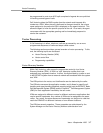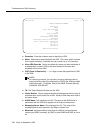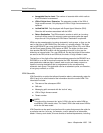
Fundamentals of Call Vectoring
3-2 Issue 4 September 1995
Call Vectoring allows the chaining of vector steps and vectors. Accordingly, one
vector can direct the call to another vector or VDN, which in turn can direct the
call to yet another vector, etc. Note, however, that a maximum of 1,000 vector
steps can be executed for any call. When a call enters vector processing, a loop
counter keeps track of the number of vector steps executed. If the loop counter
exceeds 1,000, a
stop
command is executed.
When a call is delivered to an available agent, the agent can see the information
associated with the VDN (for example, the VDN name) on his/her display (if
present) and, as a result, can respond to the call with knowledge of the service or
response required.
In the real world, of course, not every call placed to a site is immediately
answered by an agent. (The customer often has fewer agents than the maximum
simultaneous call capacity. Therefore, calls will have to be queued.) The
following sections discuss how calls are routed and/or queued via Call Vectoring.
Subsequent sections discuss agent states, priority levels, caller feedback, and
caller control.
Call Flow
Calls enter a vector and execute steps sequentially beginning with step 1, unless
there is a
goto
step. Most steps take microseconds to execute. The exception is
steps with
announcement
,
wait-time
and
collect digits
commands. A one second
wait occurs after every seven executed steps unless an explicit wait has
occurred. Note that
wait-time
with 0 seconds is not an explicit wait.
Call Vectoring uses several call flow methods to redirect and/or queue calls.
These methods involve the use of the Call Vectoring commands, which are
described later in this chapter. The methods for queuing and redirecting calls
include the following:
■ Multiple split queuing allows a call to queue to up to three splits.
■ Intraflow allows calls unanswered at a split within a predefined time frame
to be redirected to one or more other splits on the same switch. If
redirection depends upon a condition to be tested, the process is referred
to as
conditional intraflow
.
■ Interflow allows calls directed to a vector to be redirected to an external
or non-local split destination. This destination is represented by a number
programmed in the relevant vector. Calls can be routed to an attendant
(or attendant queue), a local extension, a remote [that is, Uniform Dialing
Plan (UDP)] extension, an external number, or a VDN.
■ Look-Ahead Interflow can be implemented for call centers with multiple
ACD locations connected via an ISDN-PRI. This method allows a call to
interflow only to a remote location that is better equipped to handle the
call. Look-Ahead Interflow (LAI) can occur only when the proper
conditions at the receiving switch are met.



